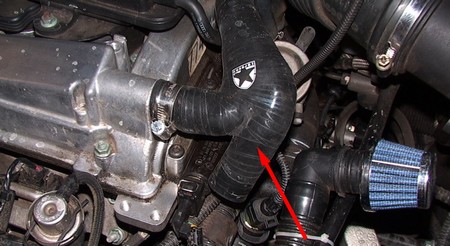Most engines manufactured since the 1960s have a positive crankcase ventilation (PCV) system, which prevents hydrocarbon vapors in the crankcase from escaping into and polluting the atmosphere. The central component of this system is the PCV valve, which is a main concern when an engine begins to idle roughly and/or stall.

Two other parts of the system can also cause trouble. One is the hose attached to the PCV valve. The other is a dirt trap that screens the air that is ingested by the crankcase to assist in the burning of hydrocarbon vapors.
A malfunctioning PCV system may be signaled by an oily residue on the air filter or by oil in the air-filter housing—a consequence of a faulty PCV component creating a pressure buildup in the crankcase. Trapped pressure forces oil out of the crankcase and into the air-filter housing, where it coats the air filter and/or causes oil to puddle on the floor of the housing.
By itself, the presence of oil in the air-filter housing does not necessarily indicate a faulty PCV system. Oil can be deposited on the filter or in the housing if valve guide seals inside the engine are worn. Furthermore, oil isn’t always present when a PCV valve, PCV hose, or PCV dirt trap fails. A closer examination of the system, therefore, is necessary. Here is how to make this inspection:
- With the engine turned off, pull the PCV valve from its seat, which could be in a rocker arm cover, intake manifold, or oil-filler cap. If you can’t locate the valve, ask a mechanic or a service manager at a dealership that sells your make of vehicle to point it out.
- Have an assistant start the engine.
- Hold your thumb tightly over the end of the valve. If you feel no suction, the valve is clogged. Turn off the engine and replace the valve.
- Even if you do feel suction, the valve still may not be performing properly, because the mechanism inside the valve may be sticking. To check this possibility, pull the valve and hose apart. Then, shake the valve. If you hear a rattle, the valve is okay. If not, take the valve to the parts department of a dealer who sells your make of vehicle or to an auto parts store and buy a new one.
- The next step is to examine the PCV hose for cracks and to make sure it has no kinks that can trap vapors and prevent free circulation. Replace a damaged hose.
- Replace the PCV dirt trap, which is inside the air-filter housing. Look for it around the rim of the housing. Again, if you can’t find it, ask a technician to point it out.
With some engines, the dirt trap is inserted in a hole in the rim of the air-filter housing. Simply pull it out of the hole and shove in a new one. Other engines require you to remove a clip on the outside of the air-filter housing to release a hose. You then push the dirt trap out of the filter housing.









